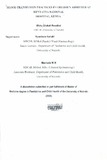| dc.description.abstract | Background: Transfusion practices have undergone intense evaluation since early 1980s
as a result of increasing awareness of the risks of blood transfusion, escalating costs of
blood processing, and diminishing supplies due to shrinking donor pool. With this in
mind. the Ministry of Health (M.O.H) Kenya has published guidelines for appropriate use
of blood. In spite of fairly clear guidelines regarding use of blood, inappropriate
transfusions continue worldwide. While transfusion is a common form of therapy for
paediatric patients at Kenyatta National Hospital (KNH), there is paucity of data as to
how the transfusion practices conform to the set guidelines.
Objective: To determine the extent to which current practices of blood transfusion for
paediatric patients at Kenyatta National Hospital conform to the set guidelines.
Setting: Kenyatta National Hospital (KNH), a large tertiary care and teaching hospital.
Design: Hospital based cross-sectional survey
Main outcome measures: Proportion of blood transfusions classified as compliant or noncompliant
with the Kenya National Guidelines for Appropriate use of Blood and
Transfusion Services (KNG-AUBTS)
Method: Over a four-month period, all blood transfusion requests, for patients aged 12
years and below were scrutinised. Demographic data, transfusion reasons/indications,
laboratory data (haemoglobin level, peV), volume of blood requested, and the degree of
urgency were noted. Vital signs, clinical assessment of the patient, the type of admission
(emergency or elective) and working diagnosis were also noted and all the details were
entered into a proforma sheet. Each transfusion episode was classified as appropriate or
inappropriate depending on whether or not it conformed to the indications in the Kenya
National Guidelines for the appropriate use of blood.
Results: Four hundred thirteen transfusions were reviewed during the 4-month period.
All the study subjects were aged 10 years and below. One hundred and seventy six
(42.6%) were male and 237(57.4%) were female. More than half (55.2%) of the
transfusion episodes occurred in children aged two months and below.
Of the three indicators used to determine appropriateness of transfusion, 298 (72.2) were
transfused for appropriate clinical indications, 152 (36.8%) had appropriate blood volume
transfused, and 271 (65.6%) were transfused within an appropriate time period of 36
hours or less. Eighty-seven (21.0%) of the transfusions fully satisfied the combined
criteria of appropriate time between request and transfusion, appropriate volume of blood
transfused and appropriate clinical indications. Of the factors evaluated ; age, gender,
reasons for blood request and time of transfusion, none significantly influenced the
appropriateness of clinical indications of blood. Appropriateness of volume transfused
was significantly influenced by reasons for blood request while appropriateness of time
interval between blood request and transfusion was significantly influenced by reasons
for blood request, blood group and time of blood request.
Conclusion: Using the recommended guidelines for appropriate use of blood, the findings
of this study indicate an extremely low rate (21 %) of appropriate blood transfusion. The
most frequent cause of deviation from the set guidelines was the volume of blood
transfused. Mechanisms of ensuring that clinicians involved in blood transfusion services
strictly adhere to the set guidelines should be instituted. One needs to look into the causes
of the wide deviation from the standards, in the volume of blood transfused. Also, causes
for the delays in blood transfusion need to be identified and rectified. | en_US |
| dc.description.department | a
Department of Psychiatry, University of Nairobi, ; bDepartment of Mental Health, School of Medicine,
Moi University, Eldoret, Kenya | |

